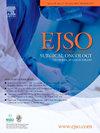Segmentectomy versus lobectomy for intersegmental small-sized non-small cell lung cancer
IF 3.5
2区 医学
Q2 ONCOLOGY
引用次数: 0
Abstract
Objectives
Intersegmental non-small cell lung cancer (NSCLC) represents a type of lesion involving at least two segments. This study aimed to demonstrate the characteristics of intersegmental NSCLC and compare the prognosis of segmentectomy with lobectomy for intersegmental NSCLC.
Methods
A retrospective study was conducted on patients with small-sized NSCLC who underwent segmentectomy or lobectomy between January 2012 and December 2020. Intersegmental and non-intersegmental nodules were determined by three-dimensional computed tomographic bronchography and angiography. The log-rank test and Cox hazard proportional regression were adopted for prognostic analyses.
Results
Totally, 1702 patients with 425 intersegmental nodules (25 %) and 1277 non-intersegmental nodules (75 %) were enrolled. Among eligible patients, 1086 patients accepted segmentectomy (intersegmental n = 188, non-intersegmental n = 898) and 616 patients underwent lobectomy (intersegmental n = 237, non-intersegmental n = 379). Intersegmental nodules were associated with larger tumor size and more lymph node metastasis (5.4 % vs. 2.1 %, P = 0.001), while intersegmental NSCLC achieved a similar prognosis to non-intersegmental NSCLC. Segmentectomy for intersegmental nodules required longer operative times, resection of more subsegments (4.06 vs. 2.91, P < 0.001), and larger resected lung volumes compared to that for non-intersegmental nodules. For patients with intersegmental nodules, the lobectomy group had larger tumor sizes, more solid nodules, and more lymph node metastasis than the segmentectomy group. After propensity score-matching, segmentectomy (n = 75) yielded comparable 5-year overall survival and disease-free survival with the lobectomy (n = 75).
Conclusion
Intersegmental nodules demonstrate a prognosis similar to non-intersegmental nodules, despite showing a higher rate of lymph node metastasis. Segmentectomy achieved long-term outcomes comparable to lobectomy for selected intersegmental NSCLC.
节段切除术与肺叶切除术治疗节段间小型非小细胞肺癌
目的:节段间非小细胞肺癌(NSCLC)是一种至少涉及两个节段的病变类型。本研究旨在阐明节段间非小细胞肺癌的特点,并比较节段切除术与肺叶切除术治疗节段间非小细胞肺癌的预后。方法回顾性分析2012年1月至2020年12月行小细胞肺癌节段切除术或肺叶切除术的患者。通过三维计算机断层支气管造影和血管造影确定节段间和非节段间结节。采用log-rank检验和Cox风险比例回归进行预后分析。结果共入组患者1702例,其中节段间结节425例(25%),非节段间结节1277例(75%)。在符合条件的患者中,1086例患者接受了节段切除术(节段间n = 188,非节段间n = 898), 616例患者接受了肺叶切除术(节段间n = 237,非节段间n = 379)。节段间结节与更大的肿瘤大小和更多的淋巴结转移相关(5.4%对2.1%,P = 0.001),而节段间NSCLC与非节段间NSCLC的预后相似。节段间结节切除术需要更长的手术时间,切除更多的亚节段(4.06 vs. 2.91, P <;0.001),与非节段间结节相比,切除的肺体积更大。对于节段间结节患者,与节段切除术组相比,肺叶切除术组肿瘤体积更大,实性结节更多,淋巴结转移更多。倾向评分匹配后,节段切除术(n = 75)与肺叶切除术(n = 75)的5年总生存率和无病生存率相当。结论节段间结节预后与非节段间结节相似,但淋巴结转移率较高。对于选择的节段间非小细胞肺癌,节段切除术取得了与肺叶切除术相当的长期结果。
本文章由计算机程序翻译,如有差异,请以英文原文为准。
求助全文
约1分钟内获得全文
求助全文
来源期刊

Ejso
医学-外科
CiteScore
6.40
自引率
2.60%
发文量
1148
审稿时长
41 days
期刊介绍:
JSO - European Journal of Surgical Oncology ("the Journal of Cancer Surgery") is the Official Journal of the European Society of Surgical Oncology and BASO ~ the Association for Cancer Surgery.
The EJSO aims to advance surgical oncology research and practice through the publication of original research articles, review articles, editorials, debates and correspondence.
 求助内容:
求助内容: 应助结果提醒方式:
应助结果提醒方式:


